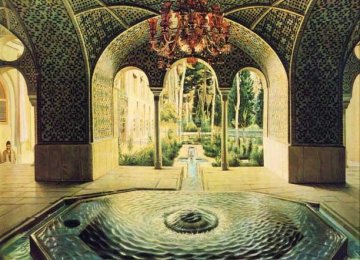Thirty-five oil paintings by Iranian painter Mohammad Ghaffari, better known as Kamal-ol-Molk (1859-1940) have been inscribed on the National Movable Heritage List.
The officially-registered paintings are kept at Golestan Palace, one of the best historical edifices in Tehran. The subjects of the paintings include special occasions, VIPs, gardens, scenic views and buildings, including the Spring House of Golestan (palace), painted in 1889, Mehr News quoted Masoud Nosrati as saying.
Nosrati is director of the Golestan Palace Complex, a group of royal buildings dating back to the Qajar era (1785-1925).
“Kamal-ol-Molk created 170 paintings, of which the masterpiece ‘Mirror Hall’ is the most famous,” Nosrati said. For five years he worked on it and it is his first painting signed with his honorary title Kamal-ol-Molk (perfection of the realm). “Mirror Hall was inscribed on the National Movable Heritage List last year.”
His other works are kept in Sa’dabad Cultural Complex, the Majlis Museum and Malek National Museum in Tehran. Malek Museum is home to a number of his works created during his tours of Italy, France and Austria. They include copies of Rembrandt’s St. Matthew and the Angel, Titian’s The Entombment of Christ and Chained Man by Robins, Nosrati said.
Life of Kamal-ol-Molk
Kamal-ol-Molk was a court painter of European academic style in the late Qajar and early Pahlavi periods. Later during the Constitutional Revolution (1905-1911), he was a freedom-loving artist and an ardent supporter of the revolution.
In spite of facing severe financial difficulties during this period, Kamal-ol-Molk refrained from painting the portrait of Mohammad Ali Shah, the sixth Qajar king and was heedless to the pressures from courtiers and the monarch’s offer of a substantial sum for the work.
As an artist skeptical of many traditional values, Kamal-al-Molk often came into conflict with the more traditional views of the time; in particular, his relationship with elders in his extended family was not without tension.
He was a thoughtful and resourceful teacher in dealing with his students, much more so than in his relations with his own family.
The heroic image of Kamal-ol-Molk was popularized in a film by film director and screen writer Ali Hatami (1944-1996), Kamal-ol-Molk, released in 1984, which focused on his role in the Constitutional Revolution.





